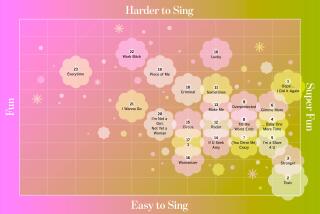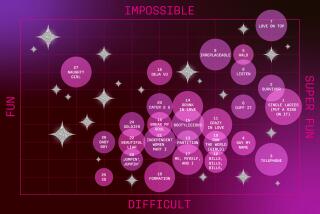Carried Away by <i> Karaoke</i> : Makers of Sing-Along Machines Hope to Tap Home Market
- Share via
Ron Arnone inherited a love of song from his father, who had once been a vaudeville performer. The problem is, Arnone can’t sing--at least he thought he couldn’t until he stumbled upon karaoke .
“I was pretty much a shy guy before then,” the former advertising consultant said. But one day he bought a sing-along system for his office, “just to show clients,” and began toying with it.
That was four years ago. Now the Hollywood native is president of the Karaoke International Sing-Along Assn. and editor of the industry’s only trade magazine. He says karaoke has completely transformed his life personally and professionally.
The karaoke industry, estimated at $590 million for 1992, promises to affect the lives of many more this year, when mainstream manufacturers of electronic equipment widely distribute karaoke sing-along systems to the American public for home use. Makers of karaoke hardware, as well as songs and accessories, look at the rest of 1992 as a myriad of business expansion possibilities.
“It’s going to bring about a major change in how Americans look at home entertainment,” said Neil Friedman, executive director for the Simi Valley-based karaoke association. “The public will see that karaoke sing-along will be the freshest and most exciting way to bring family and friends together.”
Karaoke , a concept that allows people of all ages to sing to soundtracks from which the vocals have been removed, originally gained popularity in Japanese nightclubs and bars. Literally translated, the word means empty orchestra.
In the United States, karaoke has found a comfortable niche in the nightclub and bar scene. There are now more than 10,000 clubs and bars that use karaoke in some form nationwide, compared to 1,000 clubs five years ago. The electronics side of the industry has grown at a rate of about 80% each year.
Such commercial exposure has made room for manufacturers to introduce advanced karaoke home equipment to the mainstream here in the states.
The most common form of karaoke home equipment now on the market is an audiocassette player. Although it is easy to create a makeshift karaoke set, companies such as Lonestar Technologies Ltd. of Hicksville, N.Y., manufacture sets that combine the basic elements of karaoke : microphone, music and amplifier.
Advanced systems, such as laser disc, videocassette, and interactive compact disc players, allow the singer to sing into a microphone with echo, pitch and key controls, sometimes with words on a screen or a video in the background.
“It makes someone who can’t sing at all sound a hell of a lot better,” Friedman said.
But it is the lyrics displayed on screen--like a TelePrompTer--that brings the element of fantasy to karaoke. By reading on screen as opposed to out of a song book, the singer gets to see the audience at home or in a club, and the audience can sing along with the performer.
“That is the magic,” Arnone said. “You go from being a ‘wanna-be’ to a reality when you see the audience watching and singing with you.”
The two major manufacturers of karaoke electronic equipment for consumer use are Pioneer Laser Entertainment and Nikkodo U.S.A. The success of their products has created a demand among consumers, making it possible for others to introduce equipment.
This second phase of equipment makers tested karaoke equipment for the first time to gauge public reaction in January at the Consumer Electronics Show, an industry trade show in Las Vegas. Later this month, a second electronics show will be held in Chicago, but this time it will be open to the public.
“The consumer side of karaoke is coming of age now because many Japanese manufacturers’ products have been around, but they haven’t been imported here,” Arnone said. “Now it’s starting to happen.”
Sanyo introduced a karaoke laser disc player, its first home unit available in the United States, at the January trade show. Functioning as a laser disc and karaoke player simultaneously, the machine has a retail price of about $800.
Although the company also displayed several other karaoke home units already available in Japan, the laser disc player will be the only new karaoke product Sanyo plans to release in the United States this year, said David Claus, a company spokesman.
Panasonic will introduce its own version of a “combi” player at the end of the year with functions similar to those of Sanyo’s. The company’s short-term plan is to market the product to the Asian community. But in the long run, Panasonic hopes the general public will accept its version of home karaoke .
Despite the excitement and interest that has recently surrounded technological developments in karaoke hardware, the industry remains primarily driven by the music. Without quality music, karaoke singers say it is difficult to get really involved.
The demand for good songs has software manufacturers, such as the Priddis Music Corp. in Utah, expanding their product lines and developing new formats for existing products.
Since 1984, Priddis has produced karaoke music on audiocassettes, but business is doubling each year, and owner Rick Priddis is switching his product line to compact disc later this year.
Priddis, which got its start by selling music to beauty pageants, now distributes to Tower Records and other major record and musical instrument stores. “It was an ethnic program in the Little Tokyos of big cities, and it’s still ethnic,” Friedman said. “But in the last three years it has moved into the mainstream.”
More to Read
Inside the business of entertainment
The Wide Shot brings you news, analysis and insights on everything from streaming wars to production — and what it all means for the future.
You may occasionally receive promotional content from the Los Angeles Times.










